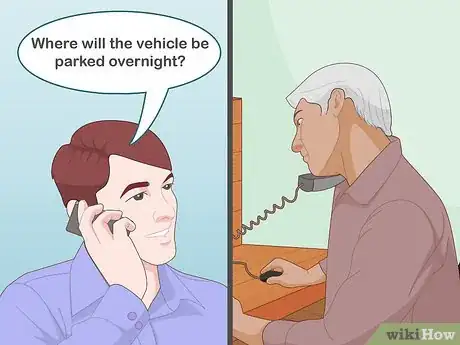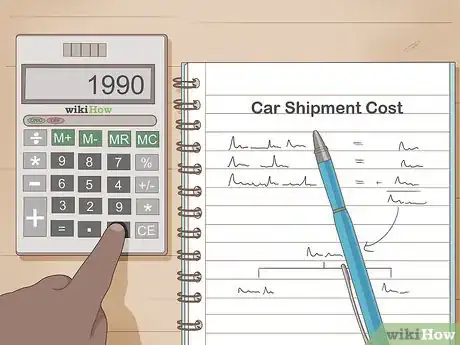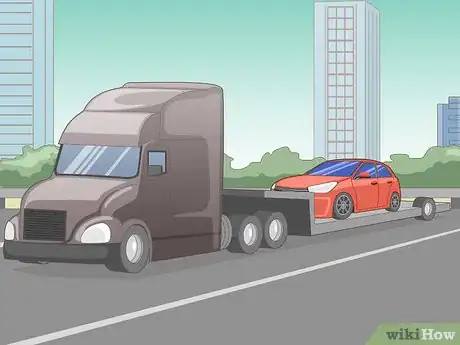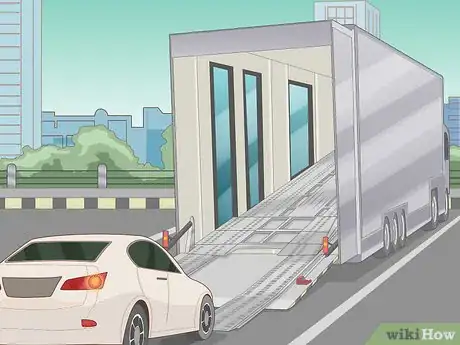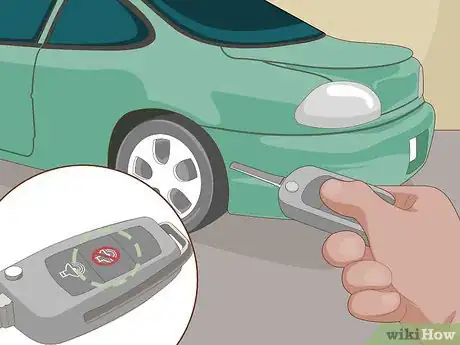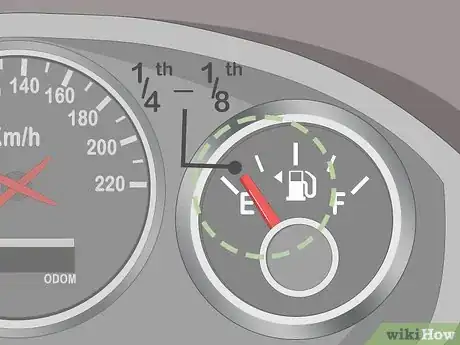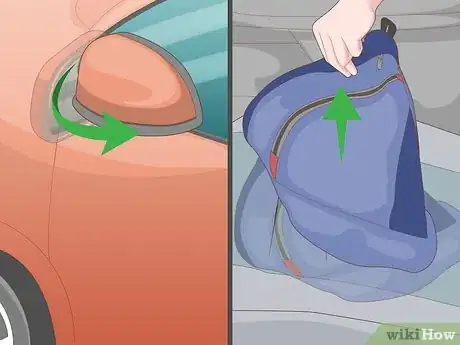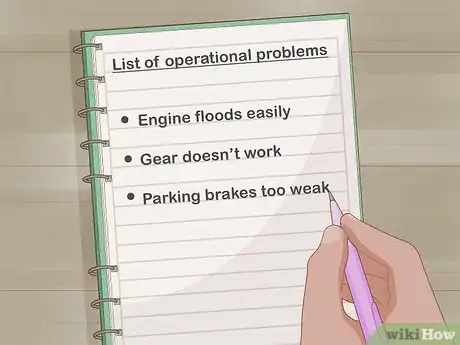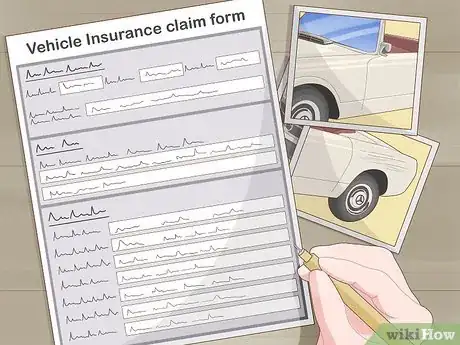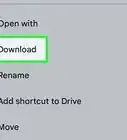This article was co-authored by wikiHow Staff. Our trained team of editors and researchers validate articles for accuracy and comprehensiveness. wikiHow's Content Management Team carefully monitors the work from our editorial staff to ensure that each article is backed by trusted research and meets our high quality standards.
There are 10 references cited in this article, which can be found at the bottom of the page.
This article has been viewed 81,262 times.
Learn more...
Car owners often ship their vehicles when they’re moving between states, regions, or even between countries. You can also have a car shipped to you if you purchased it from a faraway dealership and would rather not pick it up in person. Shipping your car saves you the hassle of having to drive your car a great distance. If you’d like to ship your car, you’ll need to contact a transportation company, determine which shipping option is right for you, and prepare your car for the move.
Steps
Finding a Vehicle Transportation Company
-
1Look for a shipping company or a broker company online. The Internet is a great resource when it comes to finding car-shipping companies. The companies’ websites will describe their services and qualifications. Many of the companies that you will find online will be broker companies. For a fee, these organizations will save you some work by finding you a car-hauling company to transport your vehicle.[1] If you’d like to check out some popular shipping companies, look into:
- Vehicle Transport Services, at: https://vehicletransportservices.co.
- Car Shipping Carriers, at: https://carshippingcarriers.com.
- uShip, at: https://www.uship.com/vehicles/.
- If you’d like to review and compare shipping brokers, use the search function provided by the Auto Transport Quote Services at: https://autotransportquoteservices.com.
-
2Contact a vehicle transporter to make sure it has credibility. If you found a shipping company online, it’s smart to make a phone call and talk to a company representative before selecting a company to ship your car with. A little research goes a long way when it comes to shipping companies. Ask questions until you feel comfortable with the transport company and with the price that the transportation will cost.[2] A company is credible if it is transparent in its business dealings, can accurately describe how its business practices work, and has positive online reviews from other customers. You can ask things like:
- "Where will the vehicle be stored or parked overnight?"
- "Do you guarantee delivery within a certain number of days?"
- Also make sure that the shipping company is licensed with the Federal Motor Carrier Safety Administration. Use their search tool at: https://ai.fmcsa.dot.gov/hhg/search.asp.
Advertisement -
3Calculate the price of the car shipment. If you’re struggling to decide between 2 or 3 different shipping companies, a quick price comparison can help you make up your mind.[3] You can calculate the shipment price by inputting information into the shipping company’s website including: the car’s make and model, its condition (running or non-running), its pickup point and destination, and whether it should be shipped on open or enclosed transport.
- If you’re working with a shipping company that doesn’t have an online presence, make a phone call to their office and ask about cost.
- The price of shipping is usually determined by the distance the car is being shipped, the popularity of the route, and the season in which the transport is taking place.
-
4Ship your car via open-car shipping for a popular and affordable option. There are 2 different ways of shipping vehicles, and they differ in cost and practicality. The methods are: open-car shipping and enclosed-car shipping. When shipped via open car, the vehicle is uncovered. This method is used frequently and is cheaper than shipping your car in closed trailers.[4]
- However, your vehicle will be exposed to the natural elements while being transported.
-
5Ship your car via enclosed shipping for added protection. An enclosed car shipping service uses a vehicle with a covered freight area. This style is most commonly used when shipping an expensive vehicle or classic car that you wish to protect. If your vehicle will be traveling cross-country and going through dry or rocky territory, consider using a closed trailer to protect it from wind-blown sand and stones.[5]
- Note that closed trailers usually cost about 60% more than open trailers, since they're smaller and can hold fewer vehicles.
-
6Look into the insurance coverage that the shipping company offers. In most instances, your car insurance will not cover a shipped vehicle, since you’re not physically driving the vehicle. However, it’s still worth checking your policy, as some may cover shipping incidents. Also contact the shipping company and ask about their insurance, should your car get damaged while being shipped.[6]
- Reputable companies with good insurance should be able to completely cover any damage that your car receives while being shipped. Companies may insure from anywhere between $50,000-$1,000,000 worth of damage.
- If you’d like a quick answer, it may be most effective to call the company directly to ask about insurance. Ask something like: "What kind of insurance will cover my car in case it's damaged or stolen?"
Preparing and Shipping Your Car
-
1Schedule a pickup or wait for an open-transport date. For most car shipments, the transportation company will contact you and let you know when they have an open slot on a shipment vehicle. The company will give you, for example, a week’s notice before your car will be ready to ship. If the shipping dates aren’t flexible and the car must be picked up on a certain day, you can contact the company and schedule a pickup.[7]
- If you request a specific scheduled pickup, the shipping company will charge you extra money.
-
2Wash your car by hand thoroughly. This is a mandatory first step, even if the car will be shipped on an open trailer. You want to be able to note any chips, dings, nicks, or other cosmetic damage accurately. If you ship your car without washing it first, it'll be difficult to tell if a nick or dent is new or existed before the car was shipped.[8]
- You can wash your car by hand using only a bucket, water, soap, and a few clean rags.
-
3Shut off or disable the car alarm. The shippers will take precautions to keep your car safe, and so you won't need to have the car alarm turned on. Before the shippers pick up your car, either fully shut off the car alarm, or temporarily disable it so that you can easily turn it back on when you pick the car up. Refer to your car manual to find out how to disable the alarm. You may need to work through an electronic menu system particular to your car.[9]
- While the shippers will still be able to transport the vehicle if the car alarm is on, it will be an unpleasant and loud experience for them.
-
4Leave the car's gas tank less than half full. Since you’re not driving the car to its destination, there's no need to have the car shipped with a full tank of gas. Shipping companies often prefer to ship cars with the gas tank close to empty. Gas is heavy, and a full tank of it may over-load the shipping truck.[10]
- If the gas tank is low, between 1/8th to 1/4th of a tank, it will save quite a bit of weight.
-
5Secure any small parts that could snap off of your car during shipping. For example, secure or remove any loose parts or specialty items from your car such as ground effects, spoilers, or fog lights.[11] These could become damaged or break off while the car ships, and the shipper's insurance may not cover this type of item.
- If you have wide side mirrors, fold them back.
- Be sure to lower and remove/retract the antennae.
- Also remove any personal items from your car. The shipping company will most likely not insure that personal items left behind will still be inside the car when it's delivered.
-
6Take note of any pre-existing damage on your vehicle. You may want to go as far as taking (and dating) pictures of the vehicle prior to shipping it. Then, compare these photographs with more photos you'll take after the vehicle arrives at its destination. These photos will show if the car was damaged while being shipped and will be valuable evidence to show the insurance company if you file for damages.[12]
-
7Take your car to the pickup location. Most shipping companies will provide you with a location that you’ll bring your car to on the day it ships. The company will also specify a time at which you should bring your car by the pickup location. Bring your car to the location about 5 minutes ahead of schedule. Or, if your shipping company is picking up your car, have it in the street, ready to go by the pickup time.[13]
- When dropping off your car, be sure to your car keys with the driver. Otherwise, they’ll be unable to start your car and it move onto the truck.[14]
-
8Bring your driver’s license, vehicle registration, and proof of insurance. These 3 documents will verify your identity and prove that the car is registered in your name. If the registration and proof of insurance are not already in your glove box, make sure to put them somewhere in the car before you drop it off for shipment.
- The driver or a business representative from the shipping company may need to write down your ID number and your insurance policy number.
-
9Sign the paperwork provided by the shipping office. Before the shipping company can transport your vehicle, they’ll need you to fill out and sign some paperwork. If you’re shipping your vehicle internationally, you may need to sign forms dealing with import laws in the country the car is going to. The company may ask you to review and sign documents including:[15]
- A shipping invoice.
- A certificate of origin certifying the country which the shipped items are coming from.
- Forms listing payments received and any outstanding financial balance.
-
10Prepare a thorough list of any operational problems. The shipping company will appreciate your thorough descriptions of any difficulties that they may have when trying to start, stop, or drive your vehicle on and off of the trailer. Print this information on a sheet of paper that you’ll leave in the vehicle when it’s shipped. Or, send a shipping company representative an email describing your car’s problems or quirks.
- For example, let the shipping company know if the engine floods easily, if a certain gear doesn’t work, or if the parking break is too weak to hold the car in position when it’s parked on an incline.
Picking Up the Car
-
1Pick up the vehicle at the arranged date and time. Depending on the shipping company you’ve used, you may have some input as to where the car is dropped off. Other companies will simply inform you where they’re going to leave your vehicle. Be there to pick your car up when it’s dropped off.[16] Most domestic shipping companies will take about 4 weeks to deliver the car.
- Contact the shipping company if your car is being shipped and you haven’t heard when or where it will be dropped off.
- If the shipping truck has had delays or problems on the road, it’s the shipping company’s responsibility to inform you.
-
2Sign the necessary paperwork to finalize the shipment. When the vehicle is dropped off, you’ll need to sign some forms indicating that the shipping company has received its payment(s) and you have received your car. The shipping company may also mail this paperwork to you after you’ve dropped the car and ask you to sign and return the forms.
- Do not sign any paperwork finalizing the business transaction until you’ve had at least 15 minutes to inspect the car for damages.
-
3Check the vehicle for new damages when you pick it up. Cars can become damaged while being shipped, whether from flying rocks and debris or from hailstorms or vandalism. To find out if your car has been damaged, walk around the vehicle and inspect it closely upon delivery. You could even take a few photographs to show the insurance company in case you realize that the shipping company damaged your vehicle.[17]
- If you’re shipping your own vehicle to a new residence, it would also be wise to take a few photographs of the car before you have it shipped.
- That way, if the car is damaged on the road, you’ll have tangible proof to show the insurance company.
-
4File an insurance claim if the car is damaged upon pickup. If your car is damaged upon arrival, you can contact the shipper’s insurance company and file a claim. When speaking to a representative on the phone, describe the new damages that your car has received. Provide the date and time of the vehicle’s drop-off, and get the name and license number of the shipping truck’s driver.[18]
- Also explain that you have taken photographs and that you have a written record of all damages to the car that pre-existed its shipment.
Community Q&A
-
QuestionWhat kind of tarp can I buy to securely cover the car?
 Community AnswerUnless you're purchasing an enclosed transport service, you're not supposed to cover the vehicle during open transport. The simple reason is that if that tarp flies off and lands on a vehicle behind the truck and causes an accident, it's going to be the trucker's responsibility.
Community AnswerUnless you're purchasing an enclosed transport service, you're not supposed to cover the vehicle during open transport. The simple reason is that if that tarp flies off and lands on a vehicle behind the truck and causes an accident, it's going to be the trucker's responsibility. -
QuestionIs it necessary to service the vehicle before shipping?
 Community AnswerGenerally, most cars that are shipped are daily drivers and are already in good running condition. If you're shipping a vehicle that has been inoperative for a while, it is advisable to get the vehicle mechanically inspected or serviced.
Community AnswerGenerally, most cars that are shipped are daily drivers and are already in good running condition. If you're shipping a vehicle that has been inoperative for a while, it is advisable to get the vehicle mechanically inspected or serviced. -
QuestionHow do you disable the alarms?
 Community AnswerRemove the car battery, or at least unhook it. Many shippers do not want to be responsible for car batteries in their shipments.
Community AnswerRemove the car battery, or at least unhook it. Many shippers do not want to be responsible for car batteries in their shipments.
Warnings
- If you're shipping a car internationally, some countries may require you to pay an import tax before bringing a car from a foreign country in their country. For example, you might have to pay an import tax if you drive from the U.S. to Canada or Mexico or from Malaysia to Singapore.⧼thumbs_response⧽
- Contact the embassy of the country you are moving to about any restrictions on shipping cars from other countries along with the required taxes.⧼thumbs_response⧽
References
- ↑ https://www.fmcsa.dot.gov/protect-your-move/resources/consumer-advisory-automobile-transporters
- ↑ https://www.consumerreports.org/consumer-protection/find-a-moving-company-you-can-count-on/
- ↑ https://vehicletransportservices.co/how-to-ship-a-car-from-one-state-to-another-across-country/
- ↑ https://cars.usnews.com/cars-trucks/how-to-ship-a-car
- ↑ https://cars.usnews.com/cars-trucks/how-to-ship-a-car
- ↑ https://cars.usnews.com/cars-trucks/how-to-ship-a-car
- ↑ https://cars.usnews.com/cars-trucks/how-to-ship-a-car
- ↑ https://www.moving.com/tips/8-tips-prepare-vehicle-auto-transport/
- ↑ https://www.mymovingreviews.com/move/prepare-car-for-shipping
- ↑ https://cars.usnews.com/cars-trucks/how-to-ship-a-car
- ↑ https://www.moving.com/tips/8-tips-prepare-vehicle-auto-transport/
- ↑ https://cars.usnews.com/cars-trucks/how-to-ship-a-car
- ↑ https://cars.usnews.com/cars-trucks/how-to-ship-a-car
- ↑ 3/18/2020
- ↑ https://www.shippingsolutions.com/blog/documents-required-for-international-shipping
- ↑ https://www.military.com/money/pcs-dity-move/shipping-a-car-overseas.html
- ↑ https://cars.usnews.com/cars-trucks/how-to-ship-a-car
- ↑ https://www.dmv.org/insurance/tips-for-filing-a-car-insurance-claim.php
About This Article
To ship a car, start by finding a shipping company online that specializes in moving cars, such as uShip or Ship a Car Direct. Then, contact a few companies to get quotes, and make sure they offer insurance if your car is damaged during transport. Next, prepare your car by shutting off the alarm, leaving less than a half tank of gas in it, and removing any personal items. Additionally, take note of any current damage to your car, such as nicks or dings, before you drop it off at the pickup location. To learn how to file an insurance claim if your car was damaged during shipping, read on!

